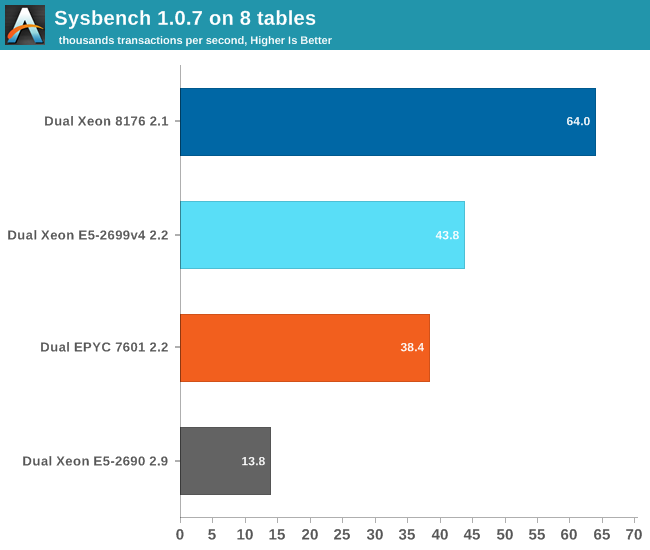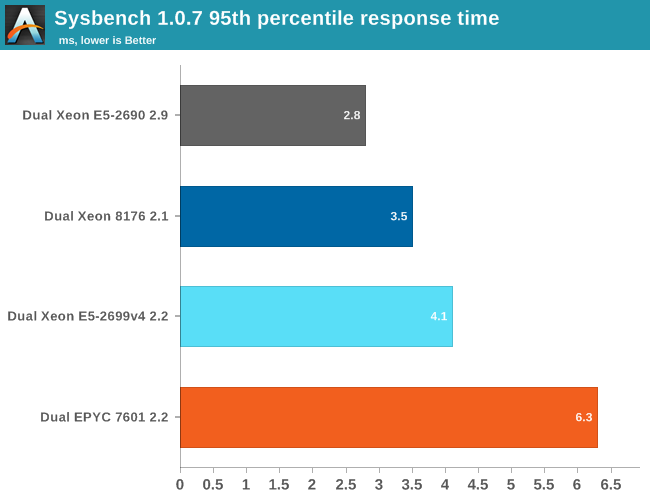Sizing Up Servers: Intel's Skylake-SP Xeon versus AMD's EPYC 7000 - The Server CPU Battle of the Decade?
by Johan De Gelas & Ian Cutress on July 11, 2017 12:15 PM EST- Posted in
- CPUs
- AMD
- Intel
- Xeon
- Enterprise
- Skylake
- Zen
- Naples
- Skylake-SP
- EPYC
Database Performance: MySQL Percona Server 5.7.0
For database benchmarking we still base our testing on Percona server 5.7, an enhanced drop-in replacement for MySQL. But we have updated our SQL benchmarking once again. This time we use Sysbench 1.0.7, which is a lot more efficient than the previous 0.4 and 0.5 versions. As a result, the measured numbers are quite a bit higher, especially on the strongest systems. So you cannot compare this with any similar Sysbench-based benchmarking we have done before.
For our testing we used the read-only OLTP benchmark, which is slightly less realistic, but still much more interesting than most other Sysbench tests. This allows us to measure CPU performance without creating an I/O bottleneck.

As expected, the EPYC 7601 can not deliver high database performance out of the box. A small database that can be mostly cached in the L3-cache is the worst case scenario for EPYC. That said, there are quite a few tuning opportunities on EPYC. According to AMD, if you enable Memory Interleaving, performance should rise a bit (+10-15%?). Unfortunately, a few days before our deadline our connection to the BMC failed, so we could not try it out. In a later article, we will go deeper into specific tuning for both platforms and test additional database systems.
Nevertheless, our point stands: out of the box is the EPYC CPU a rather mediocre transactional database CPU. With good tuning it is possible EPYC may pass the Xeon v4, but the 8176 is by far the champion here. It will be interesting to measure how EPYC compares in the non-transactional databases (Document stores, Key-value...) but transactional databases will remain Intel territory for now.

Typically when high response times were reported, this indicated low single threaded performance. However for EPYC this is not the case. We tested with a database that is quite a bit larger than the 8 MB L3-cache, and the high response time is probably a result of the L3-cache latency.










219 Comments
View All Comments
alpha754293 - Tuesday, July 11, 2017 - link
Pity that OpenFOAM failed to run on Ubuntu 16.04.2 LTS. I would have been very interested in those results.farmergann - Tuesday, July 11, 2017 - link
Are you trying to hide the fact that AMD's performance per watt absolutely dominates intel's, or have you simply overlooked one of, if not the, single most important aspects of server processors?Ryan Smith - Tuesday, July 11, 2017 - link
Neither. We just had very little time to look at power consumption. It's also the metric we're the least confident in right now, as we'd like to have a better understanding of the quirks of the platform (which again takes more time).Carl Bicknell - Wednesday, July 12, 2017 - link
Ryan / Ian,Just to let you know there are better chess benchmarks than the one you've chosen. Stockfish is an example of a newer program which better uses modern CPU architecture.
NixZero - Tuesday, July 11, 2017 - link
"AMD's MCM approach is much cheaper to manufacture. Peak memory bandwidth and capacity is quite a bit higher with 4 dies and 2 memory channels per die. However, there is no central last level cache that can perform low latency data coordination between the L2-caches of the different cores (except inside one CCX). The eight 8 MB L3-caches acts like - relatively low latency - spill over caches for the 32 L2-caches on one chip. "isnt skylake-x's l3 a victim cache too? and divided at 1.3mb for each core, not a monolytic one?
Ian Cutress - Tuesday, July 11, 2017 - link
That's what a 'spill-over' cache is - it accepts evicted cache lines.NixZero - Wednesday, July 12, 2017 - link
so why its put as an advantage for intel cache, which is spill over too?JonathanWoodruff - Wednesday, July 12, 2017 - link
Since the Intel one is all on one die, a miss to a "slice" of cache can be filled without DRAM-like latencies from another slice. Since AMD has it's last level caches spread across dies, going to another cache looks to be equivalent latency-wise to going to DRAM. It wouldn't necessarily have to be quite that bad, and I would expect some improvement here for Zen2.Martin_Schou - Tuesday, July 11, 2017 - link
This has to be wrong:CPU Two EPYC 7601 (2.2 GHz, 32c, 8x8MB L3, 180W)
RAM 512 GB (12x32 GB) Samsung DDR4-2666 @2400
12 x 32 GB is 384 GB, and 12 sticks doesn't fit nicely into 8 channels. In all likelihood that's supposed to be 16x32 GB, as we see in the E52690
Dr.Neale - Tuesday, July 11, 2017 - link
I find myself puzzled by the curious omission in this article of a key aspect of Server architecture: Data Security.AMD has a LOT; Intel, not so much.
I would think this aspect of Server "Performance" would be a major consideration in choosing which company's Architecture to deploy in a Secure Server scenario. Especially in light of Recent Revelations fuelling Hacking Headlines in the news, and Dominating Discussions on various social media websites.
How much is Data Security worth?
A topic of EPYC consequence!